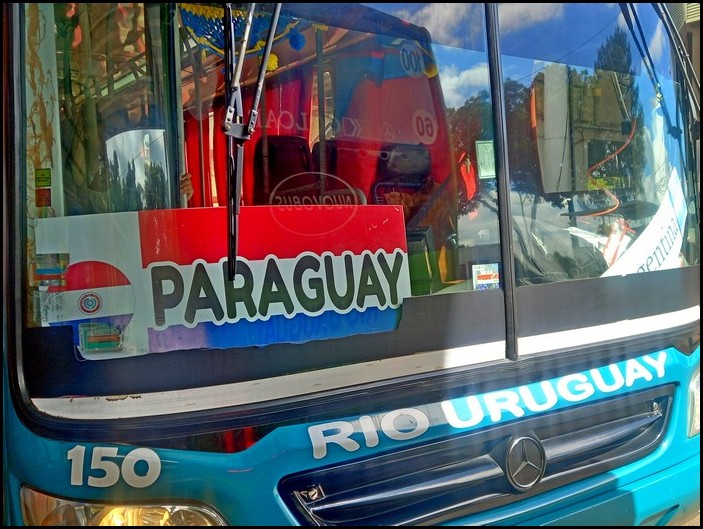
Introduction to Paraguay
Last week I arrived in Paraguay, making this my seventh country to visit in South America. I’ll be traveling around Paraguay for about three weeks.
Getting here was utterly simple. I just took a regular, one-hour bus from Puerto Iguazu, Argentina, across the border into Brazil, where we drove in-transit for about 30 minutes and then crossed a big bridge and the border into Paraguay.
As soon as we landed on the Paraguayan side of the bridge, I noticed distinct differences between this country and Argentina. But I’ll get into that in my next article about my first impressions of Paraguay.
In this post, I’m writing a broader overview of this little-known, jungly country. So here we go…
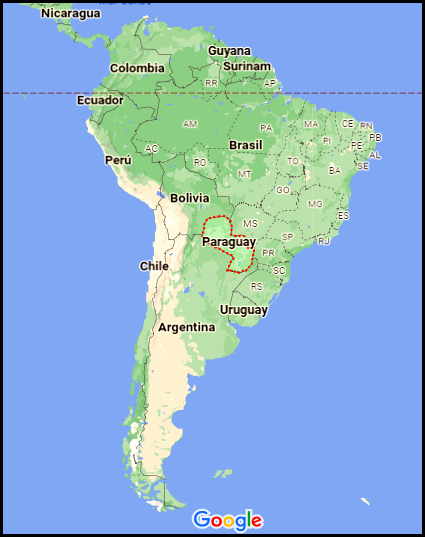
Location and Size of Paraguay
Paraguay is a small landlocked country located in the center of the continent, slightly southward. The loosely-oval-shaped country is enclosed by its three much larger neighbors: Argentina to the south, Bolivia to the northwest and Brazil to the northeast.
Although Paraguay is small, it’s actually bigger than Germany or Poland and just slightly smaller than Spain. To compare to a US state, Paraguay is slightly smaller than California. Paraguay’s total land area is 406,750 sq Km / 157,000 sq miles.
In South America, Paraguay is more than double the size of four even smaller countries. More specifically, up in the continent’s far northeast are the three tiny tropical countries of Suriname, Guyana and French Guyana. In other areas, Ecuador and Uruguay are also each only half the size of Paraguay.
Paraguay is considerably less-visited and less-famous than most other countries in South America. But it does have several worthwhile points of interest, including its captial city, Asuncion; tropical parks, jungles and waterfalls; and, rather surprsingly, excellent low-cost shopping, particularly electronics.
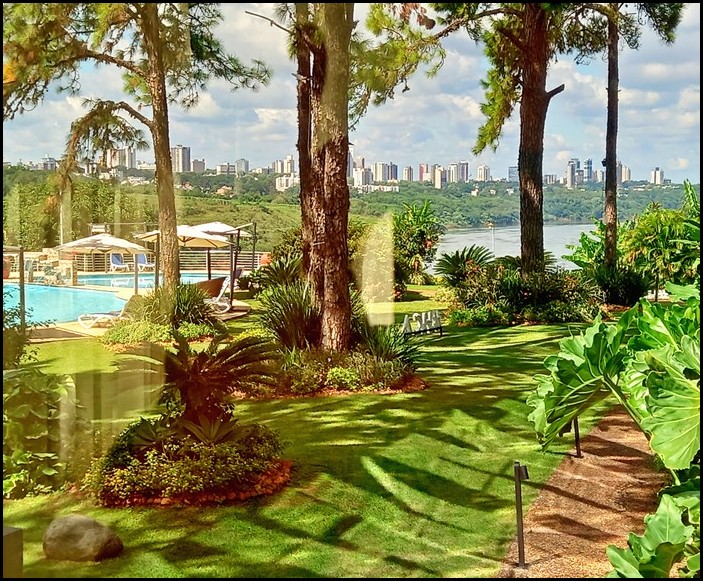
Climate of Paraguay
Although Paraguay is situated smack in the middle of the continent, not far away from the Andes Mountains and high plateaus of Bolivia, the entire country is set at a very low elevation. Paraguay is also situated at Latitude 23° South, about the same distance from the equator as Cuba and the Caribbean.
The combination of its latitude and low elevation gives Paraguay primarily a subtropical climate (like Florida). It is hot, humid and sticky most of the year. But the country does cool off in autumn and winter months to comfortable temperatures, with day-time temps about 20-28 C / 70s-low 80s F and night time temps 15-18 C / 60s F. In winter the temperatures can get as low as 0-4C / mid 30sF.
Paraguay has a lot of rain throughout the year, especially in the eastern half of the country. However, Paraguay’s far northwestern region, near Bolivia, has a semi-arid climate like its high-altitude neighbor.

Geography of Paraguay
The geography of Paraguay is surprisingly diverse, given its low altitude. The Paraguay River runs through the middle of the country, north to south. This is a major geographical dividing point. East of the river, the country is filled with hilly, grassy plains, vast agricultural plots and rolling woodlands. Further east and in southern Paraguay, bordering Argentina and Brazil, the area features dense tropical jungles.
West of the Paraguay River is a huge region called Chaco, which is characterized by low marshy lands. Further west are dry forests, scrub and finally semi-arid desert close to the border with Bolivia.
In the southeast, the broad and deep Parana River serves as border between first Brazil and then Argentina further west.
At one point, there’s a junction of the three countries. It occurs where the Uruguay River (separating Argentina and Brazil) joins the Parana River. At that junction, each country has a prominently marked monument and park where visitors can stand to see all three countries at once.
Close by, a few miles up the Uruguay River, is one of the Seven Natural Wonders of the World! The incredible Iguazu Waterfalls are the largest, most powerful waterfalls on the planet, situated on the border between Argentina and Brazil.
What to see and do in Paraguay

Junction of Three Countries
(and nearby Iguazu Falls)
As noted above, in far southeastern Paraguay, at Ciudad del Este, the country hits borders with both Brazil and Argentina at the junction of Parana and Iguazu Rivers.
That in itself can be an interesting destination. But it’s also very quick, cheap and easy to go visit world-famous Iguazu Falls as a day-trip from Ciudad del Este.
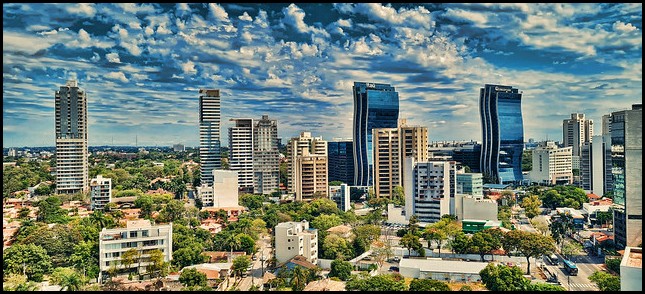
Asuncion
(modern capital city with historic colonial district)
Asuncion is Paraguay’s surprisingly modern and cosmopolitan capital. It’s situated in the far southwest, at another section of border with Argentina.
The city has a compact historic district filled with beautiful colonial buildings, leafy plazas and a long pedestrian walkway along the broad Paraguay River.
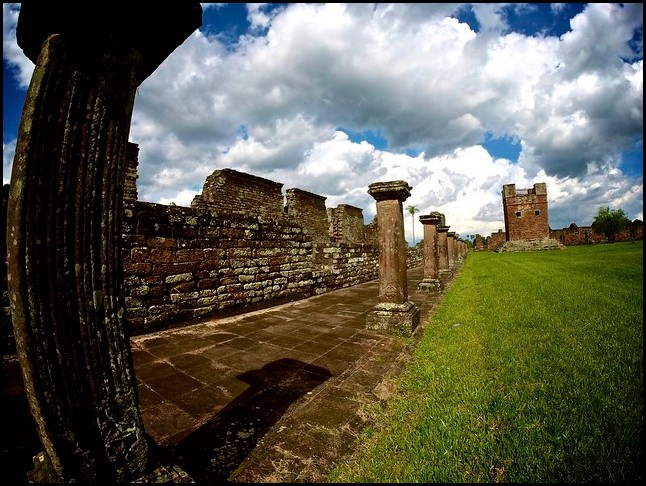
Encarnacion
(and historic Jesuit ruins)
This city, located at Paraguay’s southern border with Argentina (again), is considered the country’s prettiest. It’s situated on the banks of the Parana River and has several Jesuit ruins nearby that are rather famous with visitors.
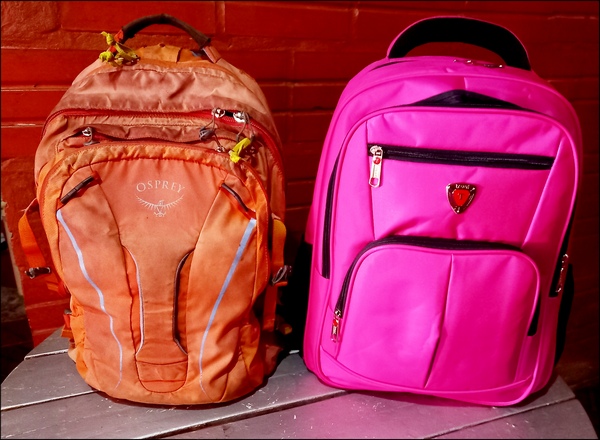
Shopping (!)
Although hard to believe, apparently Paraguay is one of the best places in the world for shopping, of all things. That’s because Paraguay is one of the world’s biggest Free Trade Zones. As a result, Paraguayans import goods from all over the world, import-tax-free.
As a result of that, Paraguayans are treated to all sorts of top-quality foodstuffs, alcohol, electronics, clothes, interiors and home-goods, and more, all at normal, international prices.
This also attracts Brazilians and Argentinians on buying sprees to purchase goods for sale back home. Since Brazil and Argentina border Paraguay at Paraguay’s Ciudad del Este, it’s extremely fast, inexpensive and easy for people to cross the borders for buying trips. Some people even go back and forth every day; their jobs to buy products for re-sale.
Supermarkets in Paraguay are huge, international-scale stores filled with huge selection of imported foods like gourmet cheeses, pastas and sauces from Europe; exotic fruits rarely seen elsewhere in South America; top shelf spirits from all over the globe; big delis serving up freshly-cooked meals; kitchen, household and toiletry goods.
I’ve been amazed at all the fantastic import foods I’ve found here. Things I found almost nowhere else in South America: Lindt chocolate, pesto sauce, persimmons, nashi (Japanese pears), gourmet cheeses…
I also took the opportunity to buy myself a great new day pack, which I’d been searching for in Argentina and Chile for several months, all to no avail. Yippie, finally a new (clean, unbroken) day bag!
Summary
Well, that’s my preliminary introduction to Paraguay. I hope you learned something new…
I’ll be traveling around the country for a couple more weeks, so I’ll be sure to fill you in on more interesting observations and info about this small semi-tropical country.
============================
You might also enjoy:
9 Things Distinctly Argentinian
============================







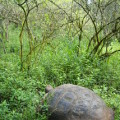
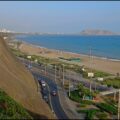

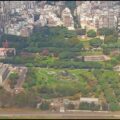

 Hi! I'm Lash, an American nomadic world traveler who's been traveling solo since 1998. I’m passionate about traveling the world nomadically and then sharing it all with you. I hope to inspire you to travel the world, to entertain you with tales from the road, and to help you reach your travel dreams. Welcome!
Hi! I'm Lash, an American nomadic world traveler who's been traveling solo since 1998. I’m passionate about traveling the world nomadically and then sharing it all with you. I hope to inspire you to travel the world, to entertain you with tales from the road, and to help you reach your travel dreams. Welcome! 



